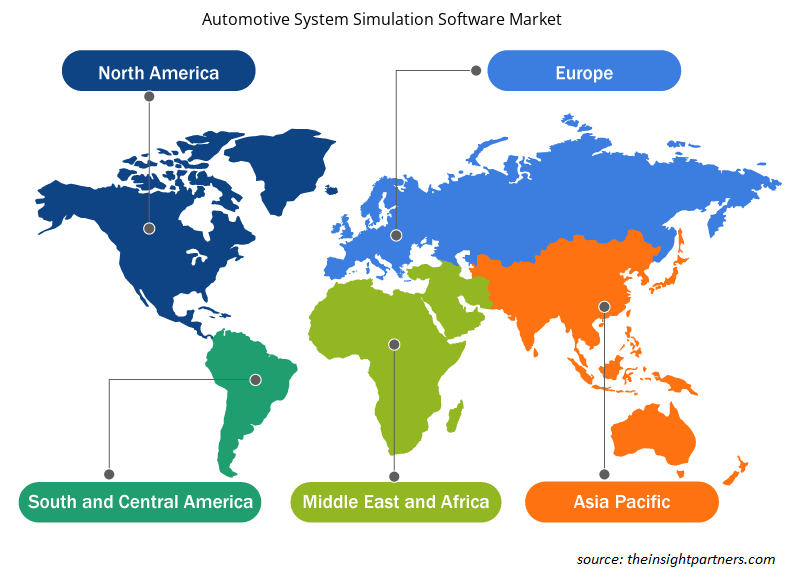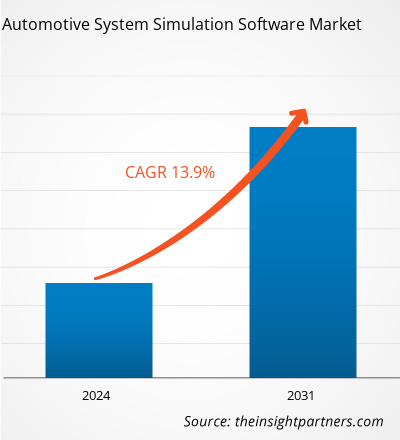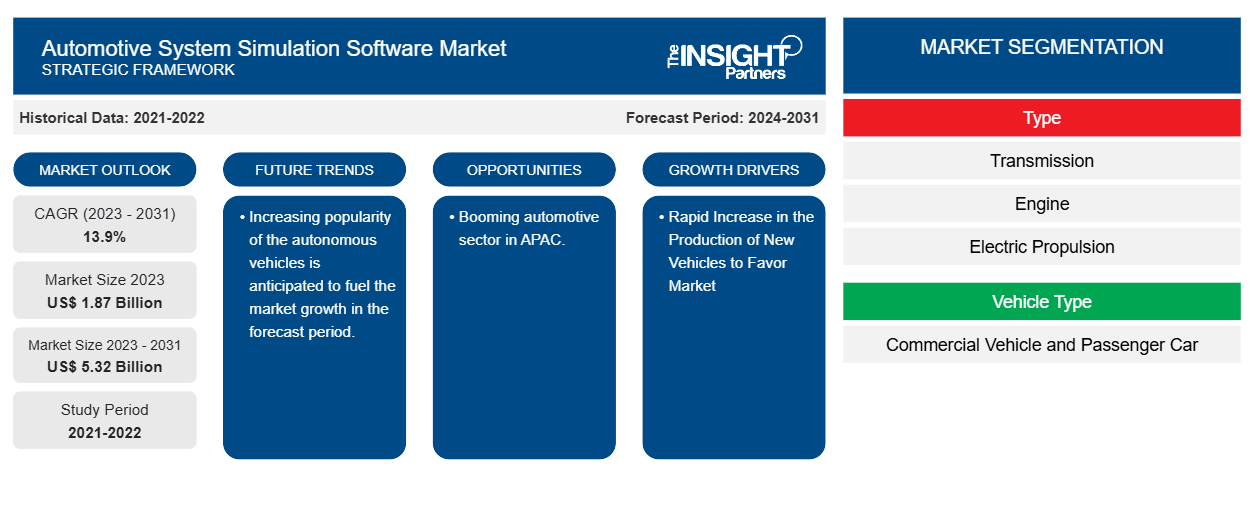자동차 시스템 시뮬레이션 소프트웨어 시장 규모는 2023년 18억 7천만 달러에서 2031년 53억 2천만 달러로 성장할 것으로 예상됩니다. 이 시장은 2023~2031년 동안 13.9%의 CAGR을 기록할 것으로 예상됩니다. 차량 기능의 업그레이드와 E/E 구성 요소의 수 증가, 전기 자동차의 생산 및 판매 증가는 시장의 주요 추세와 원동력으로 남을 가능성이 높습니다.
자동차 시스템 시뮬레이션 소프트웨어 시장 분석
자동차 시스템 시뮬레이션 소프트웨어 시장에 대한 수요는 신차 생산의 급속한 증가로 인해 증가할 것으로 예상됩니다. OEM은 기존 프로토타입 제작 방법을 자동차 시스템 시뮬레이션으로 전환하여 새로운 모델을 개발하고 기존 모델을 개선하고 있으며, 이는 자동차 시스템 시뮬레이션 소프트웨어 시장을 촉진하고 있습니다.
자동차 시스템 시뮬레이션 소프트웨어 시장 개요
자동차 시스템 시뮬레이션 소프트웨어(ASM)는 필요에 따라 병합할 수 있는 자동차 애플리케이션을 위한 시뮬레이션 모델을 포함하는 도구 모음입니다. 이 모델은 연소 엔진이나 전기 모터 와 같은 개별 구성 요소 부터 차량 역학 시스템, 복잡한 가상 교통 시나리오에 이르기까지 광범위한 시뮬레이션을 지원합니다. 이 모델은 그래픽 사용자 인터페이스인 ModelDesk를 사용하여 쉽고 직관적으로 처리할 수 있습니다.
귀하의 요구 사항에 맞게 이 보고서를 사용자 정의하세요
이 보고서의 일부 또는 국가 수준 분석, Excel 데이터 팩을 포함하여 모든 보고서에 대한 사용자 정의를 무료로 받을 수 있으며 신생 기업 및 대학을 위한 훌륭한 혜택과 할인 혜택을 이용할 수 있습니다.
-
이 보고서의 주요 시장 동향을 알아보세요.이 무료 샘플에는 시장 동향부터 추정 및 예측까지 다양한 데이터 분석이 포함됩니다.
자동차 시스템 시뮬레이션 소프트웨어 시장 동인 및 기회
신차 생산 급증으로 시장 호조세
신차 생산의 급속한 증가는 자동차 시스템 시뮬레이션 소프트웨어 시장 성장을 견인하고 있습니다. 신차 생산이 증가함에 따라 자동차 시스템 시뮬레이션 소프트웨어에 대한 수요도 증가하고 있습니다. 예를 들어, Association des Constructeurs Européens d'Automobiles(ACEA)에 따르면 2022년에 전 세계적으로 8,540만 대의 자동차가 생산되었으며, 이는 2021년 대비 5.7% 증가한 수치입니다. 따라서 신차 생산을 늘리면 자동차 시스템 시뮬레이션 소프트웨어 시장 성장을 견인할 수 있습니다.
아시아 태평양 지역에서 자동차 산업이 호황을 누리고 있습니다.
APAC의 자동차 산업은 최근 몇 년 동안 붐을 일으켰습니다. 성장은 급속한 도시화, 경제적 번영, 인구 증가에 의해 주도되었습니다. 아시아 국가의 이동성 요구는 사람과 상품에 대해 증가했습니다. 또한 자동차는 시간이 지남에 따라 현대화되고 있습니다. 게다가 KIA, Nio 등 이 지역의 많은 회사는 제품 개발에 집중하고 있습니다.
자동차 시스템 시뮬레이션 소프트웨어 시장 보고서 세분화 분석
자동차 시스템 시뮬레이션 소프트웨어 시장 분석에 기여한 주요 세그먼트는 유형, 차량 유형 및 추진 유형입니다.
- 자동차 시스템 시뮬레이션 소프트웨어 시장은 유형에 따라 변속기, 엔진 , 전기 추진, 연료 전지, 구동계, 섀시 및 기타로 구분됩니다. 변속기 부문은 예측 기간 동안 가장 큰 점유율을 차지할 것으로 예상됩니다.
- 자동차 시스템 시뮬레이션 소프트웨어 시장은 차량 유형에 따라 상용차와 승용차로 구분됩니다. 상용차 부문은 예측 기간 동안 가장 큰 점유율을 차지할 것으로 예상됩니다.
- 추진 유형을 기준으로 자동차 시스템 시뮬레이션 소프트웨어 시장은 ICE와 전기로 구분됩니다. ICE 세그먼트는 예측 기간 동안 가장 큰 점유율을 차지할 것으로 예상됩니다.
지역별 자동차 시스템 시뮬레이션 소프트웨어 시장 점유율 분석
자동차 시스템 시뮬레이션 소프트웨어 시장 보고서의 지리적 범위는 주로 북미, 아시아 태평양, 유럽, 중동 및 아프리카, 남미 및 중부 아메리카의 5개 지역으로 나뉩니다.
APAC가 시장을 지배했습니다. 이 지역은 현대 기술 발전에 집중하는 여러 제조업체의 본거지입니다. 또한 이 지역은 중국, 일본, 인도를 포함한 신흥 경제로 구성되어 있습니다. 이러한 국가는 상당한 자동차 산업을 보유하고 있습니다. 게다가 도시화와 산업화로 인해 많은 수의 차량 생산에 대한 수요가 증가하고 있으며, 이는 이 지역의 자동차 시스템 시뮬레이션 소프트웨어 시장을 촉진합니다.
자동차 시스템 시뮬레이션 소프트웨어 시장 지역 통찰력
Insight Partners의 분석가들은 예측 기간 동안 자동차 시스템 시뮬레이션 소프트웨어 시장에 영향을 미치는 지역적 추세와 요인을 철저히 설명했습니다. 이 섹션에서는 북미, 유럽, 아시아 태평양, 중동 및 아프리카, 남미 및 중미의 자동차 시스템 시뮬레이션 소프트웨어 시장 세그먼트와 지리에 대해서도 설명합니다.

- 자동차 시스템 시뮬레이션 소프트웨어 시장에 대한 지역별 데이터 얻기
자동차 시스템 시뮬레이션 소프트웨어 시장 보고서 범위
| 보고서 속성 | 세부 |
|---|---|
| 2023년 시장 규모 | 18억 7천만 달러 |
| 2031년까지 시장 규모 | 53억 2천만 달러 |
| 글로벌 CAGR (2023-2031) | 13.9% |
| 역사적 데이터 | 2021-2022 |
| 예측 기간 | 2024-2031 |
| 다루는 세그먼트 |
유형별로
|
| 포함된 지역 및 국가 |
북아메리카
|
| 시장 선도 기업 및 주요 회사 프로필 |
|
자동차 시스템 시뮬레이션 소프트웨어 시장 참여자 밀도: 비즈니스 역학에 미치는 영향 이해
자동차 시스템 시뮬레이션 소프트웨어 시장은 소비자 선호도의 변화, 기술 발전, 제품의 이점에 대한 인식 증가와 같은 요인으로 인해 최종 사용자 수요가 증가함에 따라 빠르게 성장하고 있습니다. 수요가 증가함에 따라 기업은 제품을 확장하고, 소비자의 요구를 충족하기 위해 혁신하고, 새로운 트렌드를 활용하여 시장 성장을 더욱 촉진하고 있습니다.
시장 참여자 밀도는 특정 시장이나 산업 내에서 운영되는 회사나 기업의 분포를 말합니다. 주어진 시장 공간에 얼마나 많은 경쟁자(시장 참여자)가 존재하는지 그 규모나 전체 시장 가치에 비해 나타냅니다.
자동차 시스템 시뮬레이션 소프트웨어 시장에서 운영되는 주요 회사는 다음과 같습니다.
- ESI 그룹
- ANSYS 주식회사
- 육각형AB
- dSPACE GmbH
- 지멘스
- 모델론
면책 조항 : 위에 나열된 회사는 어떤 특별한 순서에 따라 순위가 매겨지지 않았습니다.

- 자동차 시스템 시뮬레이션 소프트웨어 시장 주요 업체 개요를 알아보세요
자동차 시스템 시뮬레이션 소프트웨어 시장 뉴스 및 최근 개발
자동차 시스템 시뮬레이션 소프트웨어 시장은 1차 및 2차 조사 이후의 정성적, 정량적 데이터를 수집하여 평가되며, 여기에는 중요한 기업 간행물, 협회 데이터 및 데이터베이스가 포함됩니다. 자동차 시스템 시뮬레이션 소프트웨어 시장의 몇 가지 개발 사항은 다음과 같습니다.
- 계산 지능 분야의 글로벌 리더 중 하나인 Altair는 항공우주 및 방위 분야에서 큰 발자취를 남기고 해양, 에너지, 터보기계 및 자동차 애플리케이션에서 입지를 확대하고 있는 계산 유체 역학(CFD) 소프트웨어를 제공하는 FlightStream의 제작사인 Research in Flight를 인수했다고 발표했습니다. FlightStream은 사용자 친화적이면서도 강력한 흐름 솔버로, 고충실도 CFD 시뮬레이션과 엔지니어 및 설계자의 요구 사항 간의 격차를 메웁니다. (출처: Altair, 회사 웹사이트, 2024년 5월)
- 로데슈바르즈는 가상 테스트 주행의 선구자인 IPG Automotive와 협력하여 자동차 레이더 HIL(Hardware-in-the-Loop) 통합 테스트를 재정의하여 자율 주행(AD) 테스트를 시험장에서 개발 랩으로 가져와 비용을 절감했습니다. IPG Automotive의 CarMaker 시뮬레이션 소프트웨어와 R&S AREG800A 레이더 객체 시뮬레이터, R&S QAT100 고급 안테나 어레이를 결합하면 자동차 제조업체가 Euro NCAP에 정의된 것과 같은 ADAS/AD 시나리오를 제어되고 안전하며 시간 효율적이며 비용 절감적인 방식으로 시뮬레이션할 수 있습니다. (출처: 로데슈바르즈 회사 웹사이트, 2024년 4월)
자동차 시스템 시뮬레이션 소프트웨어 시장 보고서 범위 및 제공물
"자동차 시스템 시뮬레이션 소프트웨어 시장 규모 및 예측(2021-2031)" 보고서는 아래 영역을 포괄하는 시장에 대한 자세한 분석을 제공합니다.
- 범위에 포함된 모든 주요 시장 부문에 대한 글로벌, 지역 및 국가 수준의 자동차 시스템 시뮬레이션 소프트웨어 시장 규모와 예측입니다.
- 자동차 시스템 시뮬레이션 소프트웨어 시장 동향과 운전자, 제한 장치, 주요 기회와 같은 시장 역학에 대한 정보입니다.
- 자세한 PEST/포터의 5가지 힘과 SWOT 분석
- 주요 시장 동향, 글로벌 및 지역 프레임워크, 주요 업체, 규정 및 최근 시장 개발 사항을 포괄하는 자동차 시스템 시뮬레이션 소프트웨어 시장 분석입니다.
- 자동차 시스템 시뮬레이션 소프트웨어 시장의 시장 집중도, 히트맵 분석, 주요 업체, 최근 개발 사항을 다루는 산업 환경 및 경쟁 분석입니다.
- 자세한 회사 프로필
- 과거 분석(2년), 기준 연도, CAGR을 포함한 예측(7년)
- PEST 및 SWOT 분석
- 시장 규모 가치/거래량 - 글로벌, 지역, 국가
- 산업 및 경쟁 환경
- Excel 데이터세트
최근 보고서
관련 보고서
사용 후기
구매 이유
- 정보에 기반한 의사 결정
- 시장 역학 이해
- 경쟁 분석
- 고객 인사이트
- 시장 예측
- 위험 완화
- 전략 기획
- 투자 타당성 분석
- 신흥 시장 파악
- 마케팅 전략 강화
- 운영 효율성 향상
- 규제 동향에 발맞춰 대응























 무료 샘플 받기 - 자동차 시스템 시뮬레이션 소프트웨어 시장
무료 샘플 받기 - 자동차 시스템 시뮬레이션 소프트웨어 시장